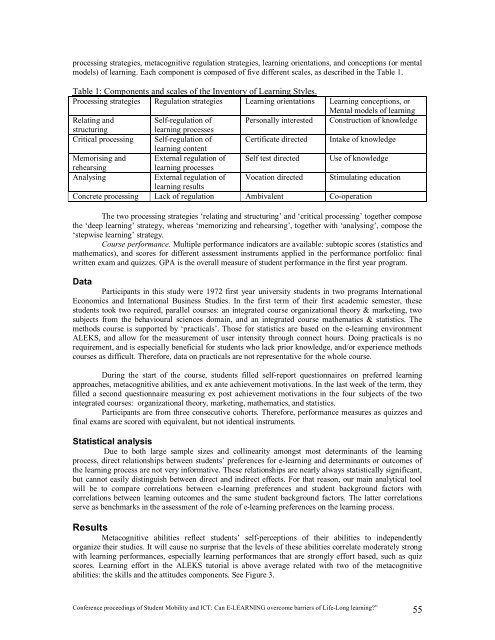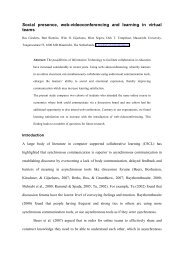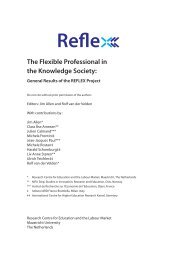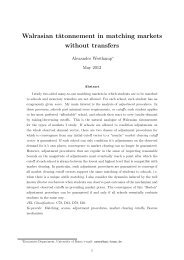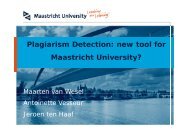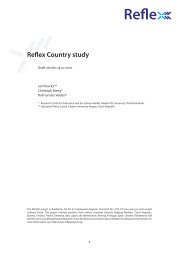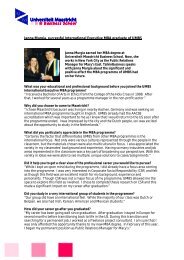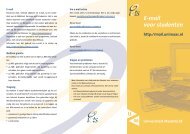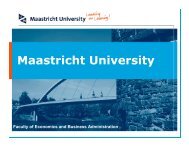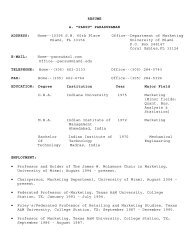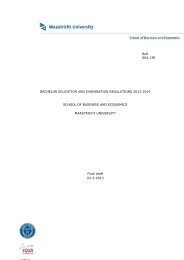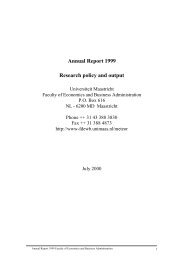proceedings of Student Mobility and ICT: Can E-LEARNING
proceedings of Student Mobility and ICT: Can E-LEARNING
proceedings of Student Mobility and ICT: Can E-LEARNING
You also want an ePaper? Increase the reach of your titles
YUMPU automatically turns print PDFs into web optimized ePapers that Google loves.
processing strategies, metacognitive regulation strategies, learning orientations, <strong>and</strong> conceptions (or mental<br />
models) <strong>of</strong> learning. Each component is composed <strong>of</strong> five different scales, as described in the Table 1.<br />
Table 1: Components <strong>and</strong> scales <strong>of</strong> the Inventory <strong>of</strong> Learning Styles.<br />
Processing strategies Regulation strategies Learning orientations Learning conceptions, or<br />
Mental models <strong>of</strong> learning<br />
Relating <strong>and</strong> Self-regulation <strong>of</strong> Personally interested Construction <strong>of</strong> knowledge<br />
structuring<br />
learning processes<br />
Critical processing Self-regulation <strong>of</strong><br />
learning content<br />
Certificate directed Intake <strong>of</strong> knowledge<br />
Memorising <strong>and</strong> External regulation <strong>of</strong> Self test directed Use <strong>of</strong> knowledge<br />
rehearsing<br />
learning processes<br />
Analysing External regulation <strong>of</strong><br />
learning results<br />
Vocation directed Stimulating education<br />
Concrete processing Lack <strong>of</strong> regulation Ambivalent Co-operation<br />
The two processing strategies ‘relating <strong>and</strong> structuring’ <strong>and</strong> ‘critical processing’ together compose<br />
the ‘deep learning’ strategy, whereas ‘memorizing <strong>and</strong> rehearsing’, together with ‘analysing’, compose the<br />
‘stepwise learning’ strategy.<br />
Course performance. Multiple performance indicators are available: subtopic scores (statistics <strong>and</strong><br />
mathematics), <strong>and</strong> scores for different assessment instruments applied in the performance portfolio: final<br />
written exam <strong>and</strong> quizzes. GPA is the overall measure <strong>of</strong> student performance in the first year program.<br />
Data<br />
Participants in this study were 1972 first year university students in two programs International<br />
Economics <strong>and</strong> International Business Studies. In the first term <strong>of</strong> their first academic semester, these<br />
students took two required, parallel courses: an integrated course organizational theory & marketing, two<br />
subjects from the behavioural sciences domain, <strong>and</strong> an integrated course mathematics & statistics. The<br />
methods course is supported by ‘practicals’. Those for statistics are based on the e-learning environment<br />
ALEKS, <strong>and</strong> allow for the measurement <strong>of</strong> user intensity through connect hours. Doing practicals is no<br />
requirement, <strong>and</strong> is especially beneficial for students who lack prior knowledge, <strong>and</strong>/or experience methods<br />
courses as difficult. Therefore, data on practicals are not representative for the whole course.<br />
During the start <strong>of</strong> the course, students filled self-report questionnaires on preferred learning<br />
approaches, metacognitive abilities, <strong>and</strong> ex ante achievement motivations. In the last week <strong>of</strong> the term, they<br />
filled a second questionnaire measuring ex post achievement motivations in the four subjects <strong>of</strong> the two<br />
integrated courses: organizational theory, marketing, mathematics, <strong>and</strong> statistics.<br />
Participants are from three consecutive cohorts. Therefore, performance measures as quizzes <strong>and</strong><br />
final exams are scored with equivalent, but not identical instruments.<br />
Statistical analysis<br />
Due to both large sample sizes <strong>and</strong> collinearity amongst most determinants <strong>of</strong> the learning<br />
process, direct relationships between students’ preferences for e-learning <strong>and</strong> determinants or outcomes <strong>of</strong><br />
the learning process are not very informative. These relationships are nearly always statistically significant,<br />
but cannot easily distinguish between direct <strong>and</strong> indirect effects. For that reason, our main analytical tool<br />
will be to compare correlations between e-learning preferences <strong>and</strong> student background factors with<br />
correlations between learning outcomes <strong>and</strong> the same student background factors. The latter correlations<br />
serve as benchmarks in the assessment <strong>of</strong> the role <strong>of</strong> e-learning preferences on the learning process.<br />
Results Metacognitive abilities reflect students’ self-perceptions <strong>of</strong> their abilities to independently<br />
organize their studies. It will cause no surprise that the levels <strong>of</strong> these abilities correlate moderately strong<br />
with learning performances, especially learning performances that are strongly effort based, such as quiz<br />
scores. Learning effort in the ALEKS tutorial is above average related with two <strong>of</strong> the metacognitive<br />
abilities: the skills <strong>and</strong> the attitudes components. See Figure 3.<br />
Conference <strong>proceedings</strong> <strong>of</strong> <strong>Student</strong> <strong>Mobility</strong> <strong>and</strong> <strong>ICT</strong>: <strong>Can</strong> E-<strong>LEARNING</strong> overcome barriers <strong>of</strong> Life-Long learning?” 55


